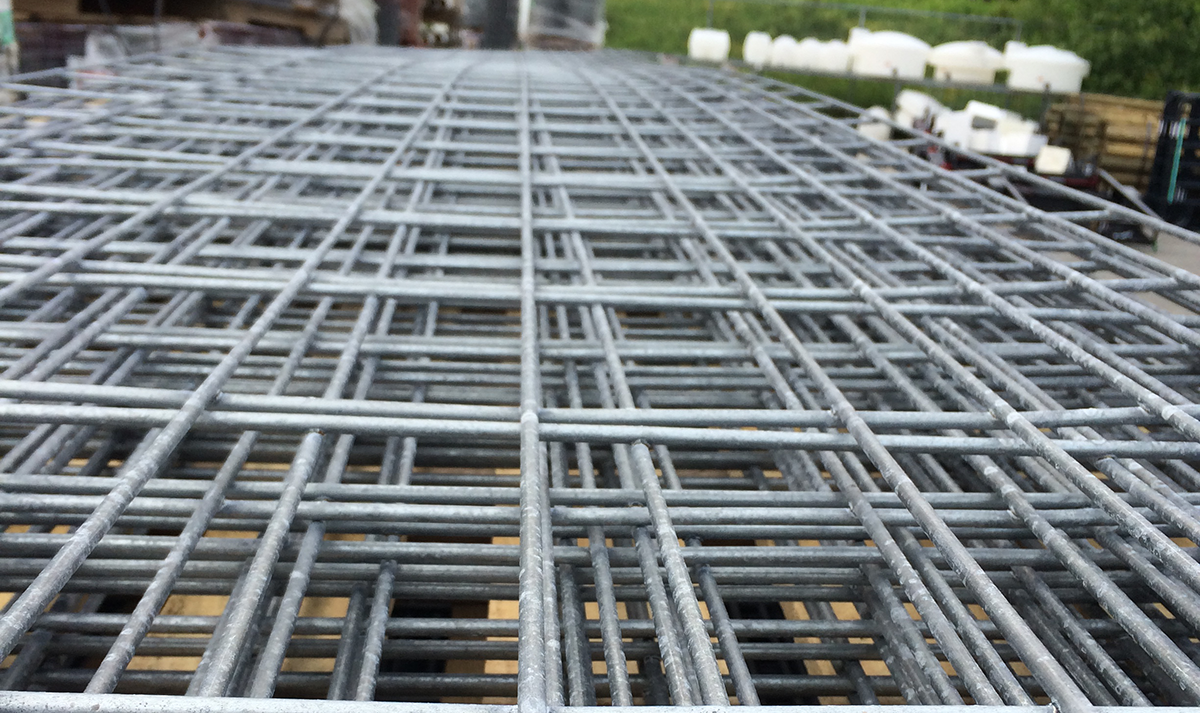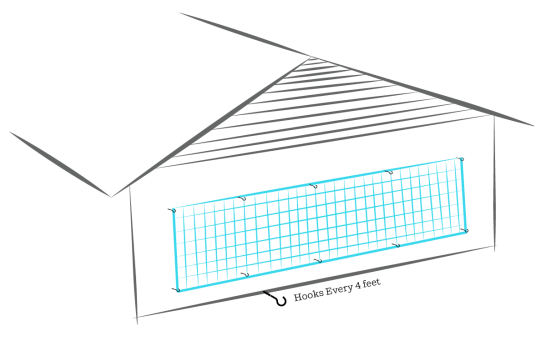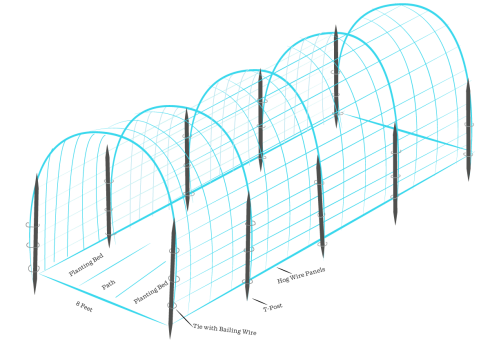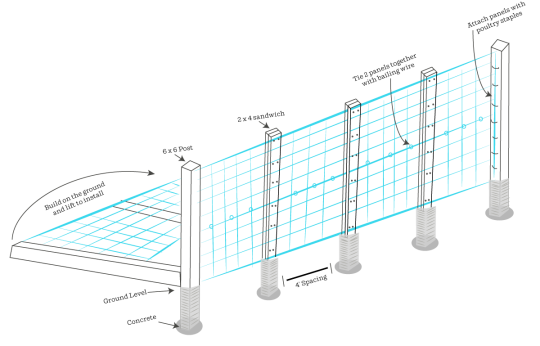The panels are typically sold in 16-foot lengths at feed stores and range from 34 inches to 50 inches in height. Technically, only the shorter panels are for containing pigs, while the taller versions are often labeled as sheep or cattle panels. The spaces between the wires are large compared to mesh fencing – usually […]

The panels are typically sold in 16-foot lengths at feed stores and range from 34 inches to 50 inches in height. Technically, only the shorter panels are for containing pigs, while the taller versions are often labeled as sheep or cattle panels. The spaces between the wires are large compared to mesh fencing – usually 4 inches by 4 inches or 6 inches by 6 inches. The wider spacing coupled with beefier wires makes hog panels more aesthetically attractive than wire mesh fencing, so it is often used in landscaping projects. Here are three ways to use them to make a trellis.
[mf_h6 align=”left” transform=”uppercase”]Wall-Mounted Trellis[/mf_h6]
Tools and Materials
34-inch or 50-inch livestock panel
10 3-inch metal hooks
1/8-inch drill bit
Drill
This version is best for lightweight annual vines like peas, beans, nasturtiums or gourds. It’s also a good choice for supporting ‘cane’ fruits, such as blackberries and raspberries. Use it on any exterior wall – house, barn or shed – that you don’t mind drilling a few holes into.
- Get two friends to hold the livestock panel flat against the wall about 6 inches off the ground. Step back and make sure it looks level. (Or use your phone’s level app.)
- Drill a 1/8-inch hole just inside the top corners of the panel and every four feet between the two corners. Repeat the process along the bottom of the panel, drilling the holes just below the bottom wire.
- Set the panel down and screw a 3-inch metal hook into each of the holes.
- Hang the panel on the hooks and plant the vines directly below it.
[mf_h6 align=”left” transform=”uppercase”]Tunnel Trellis[/mf_h6]
Tools and Materials
34-inch livestock panels
5-foot metal T-posts (four for each livestock panel used)
Baling wire
Sledge hammer or post pounder
Wire cutters
Pliers
This version works for heavier annual vines like cucumbers, squash and tomatoes. It’s also effective for medium-weight perennial vines, such as hops, passion fruit and climbing roses. The size of the panels is just right for spanning the width of two 3-foot wide garden beds with a 2-foot wide path in between.
- Pound 5-foot metal T-posts into the ground every 34 inches (or equivalent to the width of the panels you are using) for the length of the trellis you wish to build. Pound a parallel row of T-posts into the ground 8 feet away from the first row. The T-posts need to go 12 to 14 inches into the ground.
- Place one 34-inch by 16-foot panel on the ground so that the narrow ends span the space between the first two posts in your first row of T-posts. Tie the bottom corners of the panels to the posts where they touch with baling wire. You’ll need wire cutters to cut the baling wire and a pair of pliers to twist it tight.
- Lift the other end of the panel up and over the T-bar so that it rests on the ground near the opposite pair of posts. This should make an arch.
- Go back to the first pair of posts and tie the panel to them at the midpoint and top of each post.
- Tie the panel to the opposite pair of posts at the bottom, midpoint and top, as well (you’ll probably need a friend to hold the panel to the post while you tie it with the pliers).
- Repeat the process down the length of the row to form a tunnel. Plant the vines along the base on either side.
[mf_h6 align=”left” transform=”uppercase”]Fence Trellis[/mf_h6]
Tools and Materials
2 ”“ 34-inch livestock panels
2 ”“ 6-inch-by-6-inch-by-8-foot posts
Box of ¾-inch poultry staples
6 – 2-inch by-4-inch-by-8-foot boards
Box of 3-inch exterior grade screws
7 ”“ 60 lb. bags of concrete
Hammer
Drill
Post hole digger
Level
This is a large, sturdy trellis that can also be used as a fence. Use it for the heaviest vines, like grapes, kiwi and wisteria.
- Lay two 34-inch by 16-foot hog panels adjacent to each other on the ground where you want the trellis, forming a rectangle 78 inches by 16 feet.
- Lay a 6-inch-by-6-inch-by-8-foot wood post (cedar, redwood or other rot-resistant lumber) along both of the 78-inch sides of the hog panel rectangle, aligning the tops of the posts with one side of the rectangle (meaning the posts will extend 18 inches beyond the rectangular panel. That part of the post will go into the ground).
- Attach the panels to the posts by hammering in ¾-inch poultry staples every 12 inches or so along the midpoint of each post.
- Place a pair of 8-foot 2x4s (of the same type of wood as the 6×6 boards) every four feet between the posts, one on either side of the panels so they sandwich the panels in between boards. Align the boards with the panel wires so they are perfectly parallel with the end posts. The pairs of 2x4s with the panels sandwiched between them will serve as smaller middle posts to support the trellis.
- Screw the pairs of 2x4s together using 3-inch exterior-grade wood screws, making sure the tops of the boards are flush with each other and with the top wire of the rectangle. Position the screws in left and right pairs 2 inches apart and spaced every 12 inches along the length of the 2x4s (no need to use screws for the portion of the 2x4s that extends beyond the edge of the panel, as these will be set in concrete below grade).
- Use a post hole digger to dig an 18-inch-deep hole at the bottom end of the posts and 2x4s (opposite the 2×6 cap). Dig the holes 12 inches in diameter for the 6×6 posts and 8 inches in diameter for the 2x4s.
- With the help of a few friends, lift the trellis up while sliding the bottoms of the posts and the 2x4s into their respective holes.
- Mix up a batch of concrete and have helpers hold the end posts steady, using a level to make sure they are plumb (perfectly vertical), while you shovel concrete into the holes. Fill each hole with concrete and check it one last time to make sure the trellis is plumb before the concrete dries.
- Allow 24 hours for the concrete to cure. Plant the vines along the trellis.



Very nice, Ill be using all three ways